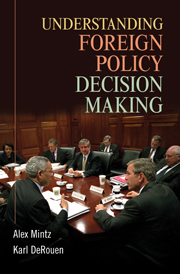Book contents
- Frontmatter
- Contents
- Acknowledgments
- PART ONE INTRODUCTION
- PART TWO THE DECISION ENVIRONMENT
- 2 Types of Decisions and Levels of Analysis in Foreign Policy Decision Making
- 3 Biases in Decision Making
- PART THREE MODELS OF DECISION MAKING
- PART FOUR DETERMINANTS OF FOREIGN POLICY DECISION MAKING
- PART FIVE MARKETING FOREIGN POLICY
- PART SIX CONCLUSION
- Appendix: Foreign Policy Simulation and Exercise
- References
- Index
2 - Types of Decisions and Levels of Analysis in Foreign Policy Decision Making
Published online by Cambridge University Press: 05 June 2012
- Frontmatter
- Contents
- Acknowledgments
- PART ONE INTRODUCTION
- PART TWO THE DECISION ENVIRONMENT
- 2 Types of Decisions and Levels of Analysis in Foreign Policy Decision Making
- 3 Biases in Decision Making
- PART THREE MODELS OF DECISION MAKING
- PART FOUR DETERMINANTS OF FOREIGN POLICY DECISION MAKING
- PART FIVE MARKETING FOREIGN POLICY
- PART SIX CONCLUSION
- Appendix: Foreign Policy Simulation and Exercise
- References
- Index
Summary
TYPES OF DECISIONS
One can speak of a variety of decision types. Some decisions are simple and, once made, can be forgotten. Other decisions must be revisited every so often and might be dependent on what a rival does in response. Some decisions are small but are part of a series of related decisions. This section introduces a number of important concepts related to decision type. These decision types are listed in Table 2.1 below.
One-shot or single decisions are rare in international affairs because most decisions are part of a sequence of decisions and/or decisions that are made interactively with other actors. However, scholars of foreign policy decision making (FPDM) often focus on the analysis of a single decision, such as the U.S. government's decision not to invade Iraq in 1991 or its decision to invade Iraq in 2003. As another example, the U.S. decision not to provide militarily aid to the French at Dien Bien Phu in 1954 was a one-shot decision. Although perhaps not a perfect example, the U.S. decision not to ratify the Kyoto Protocol might be considered another example of a one-shot foreign policy decision.
Strategic, interactive decisions are those involving at least two players who make decisions that affect and are affected by the other player's decisions. For example, Yasser Arafat, while president of the Palestinian National Authority, had to decide whether to accept, counter, or reject the offer made to him by Israeli prime minister Ehud Barak at Camp David in 2000.
- Type
- Chapter
- Information
- Understanding Foreign Policy Decision Making , pp. 15 - 37Publisher: Cambridge University PressPrint publication year: 2010



